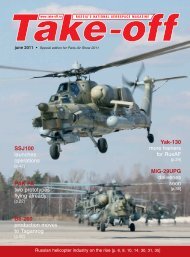You also want an ePaper? Increase the reach of your titles
YUMPU automatically turns print PDFs into web optimized ePapers that Google loves.
The United States followed by Western<br />
Europe launched proactive research into the<br />
matter on the verge of the new century.<br />
The United States even hurried to proclaim<br />
combat UAVs the ‘sixth generation’ of<br />
warplanes, which would succeed the current<br />
manned multirole fighters, including the<br />
fifth-generation F-22 and F-35, ousting<br />
them almost completely in due time. In<br />
1998–2000, the leading US aircraft<br />
makers, Boeing and Northrop Grumman,<br />
launched designing experimental technology<br />
demonstrators of such UCAVs, dubbed X-45<br />
and X-47, starting their flight evaluation in<br />
2002–03. The basic components of those<br />
UCAVs’ concept include flight performance<br />
similar to that of advanced combat aircraft;<br />
reusability and basing at frontline aircraft<br />
airfields; high survivability achieved through<br />
low observability, special design solutions and<br />
defence aids suites; ability to independently<br />
military aviation | project<br />
identify and attack targets with internallycarried<br />
PGMs; and operating both solo and<br />
as part of a package, including in conjunction<br />
with manned aircraft.<br />
The final configuration of the US drone<br />
demonstrators has featured a maximum<br />
take<strong>off</strong> weight of 16.6 t (X-45C) and even<br />
19 t (X-47B), which puts them in the same<br />
dimensional niche occupied by F-16size<br />
frontline fighters. The X-45 and X-<br />
47 experimental UCAVs were competitive<br />
designs under the J-UCAV programme<br />
providing for a combat UAV common for the<br />
US Air Force and Navy. However, the United<br />
States ditched the idea of a joint UCAV last<br />
year, and the programme – now dubbed<br />
UCAS-D – continues in the interest of the<br />
US Navy only. Although a more sobering<br />
look has been taken at UCAVs and the United<br />
States no longer regards them as a worthy<br />
replacement of manned combat aircraft,<br />
rather a complement especially effective in<br />
difficult tactical situations of high-intensity<br />
conflicts, their development will, no doubt,<br />
continue for both the USN and USAF.<br />
Besides the United States, several European<br />
countries have been developing combat UAVs<br />
recently. Experimental designs entered trials<br />
in France (Petit Duc, 2000), the UK (Raven,<br />
2003), Italy (Sky-X, 2005), Sweden (FILUR,<br />
2005), Germany and Spain (Barracuda,<br />
UNMANNED FUTURE<br />
OF COMBAT AIRCRAFT?<br />
www.take-<strong>off</strong>.ru take-<strong>off</strong> november 2007 37<br />
Andrey Fomin




